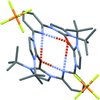issue contents
August 2015 issue

Cover illustration: A simple reaction pathway to alkylidene-substituted dihydrooxazolones and dihydroimidazolones from acylglycines is described, along with further reactions of a dihydrooxazolone to form either a 2-substituted acylglycinehydrazide, which can also be converted into a dihydroimidazolone, or a 2-substituted acylglycine. The thienyl-substituted products generally exhibit orientational disorder in the thienyl groups, and hydrogen bonding generates a range of zero-, one- and two-dimensional supramolecular assembly types. See Subbulakshmi, Narayana, Yathirajan, Akkurt, Çelik, Ersanli & Glidewell [Acta Cryst. (2015), C71, 742-751].
research papers








































 journal menu
journal menu




































